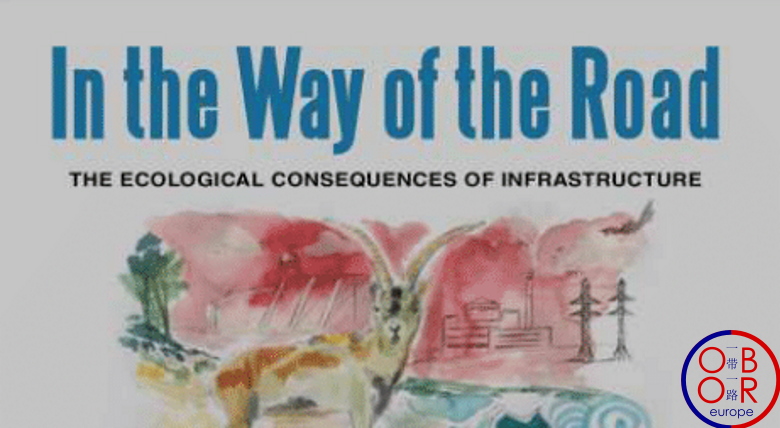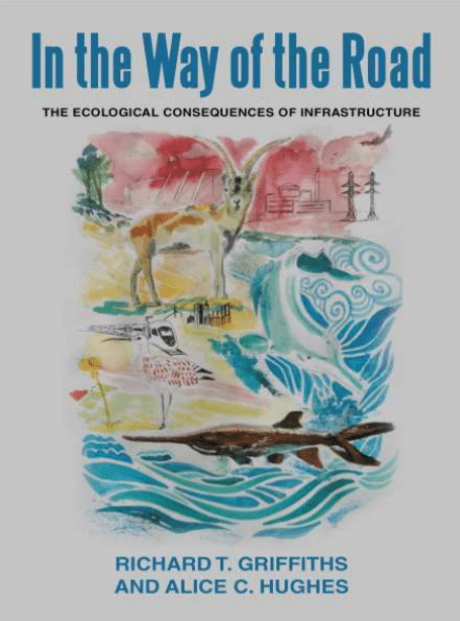Book review by Dr. Sebastien Goulard

In early 2021, Professor Richard T. Griffiths (International Institute for Asian Studies, Leiden) and Professor Alice C. Hughes (Xishuangbanna Tropical Botanical Garden, Chinese Academy of Sciences, Yunnan) edited In the Way of the Road, the Ecological Consequences of Infrastructure. Professor Griffiths (director of the New Silk Roads research project at the International Institute for Asian Studies) has already overseen publication of several books about the Belt and Road Initiative (BRI), including Revitalising the Silk Road (in 2017), and he has demonstrated his expertise in connectivity projects around the world.
Professor Griffiths’s latest book looks at the impact of the BRI on the environment and possible solutions to make this programme greener. An important point made by the authors is that there is no panacea that will solve all environmental issues. Even wind and solar energy have some negative consequences for the environment. Although environmental preservation and climate change mitigation have been identified by China as key targets for rollout of the New Silk Road, the authors note that construction of BRI corridors (in massive investment projects) endangers pristine ecosystems and local communities. Many experts point out that such projects could be significantly improved with better governance.
However, the authors recognize that more infrastructure facilities are required (mostly in developing nations) in order to address relevant social and economic issues and give local populations better opportunities. They also highlight the fact (as mentioned above) that many initiatives have consequences, and if we cannot avoid such negative impacts, we must endeavour to reduce or minimize them.
Summary
After a short introduction, giving an overview of successive chapters, Professor Griffiths and Professor Hughes examine the need for infrastructure in transport and energy, and they consider how new facilities will impact on the highly diverse ecosystems in regions along the New Silk Road. New railways, ports and pipelines in regions that, historically, have seen very little human presence can endanger local biodiversity. The authors maintain that the current COVID-19 crisis will cause the environment to deteriorate further as many countries have chosen to deregulate in order to speed up recovery.
The authors do not argue for complete preservation of the environment through which the BRI passes, which would be impossible to achieve, but they do stress the importance of minimizing the externalities. According to the authors, the first task should be to study the biodiversity in key regions and gather relevant data in order to protect these areas more effectively.
The second chapter, written by Dr Elena Tracy (Ludwig-Maximilian University of Munich), is maybe the most central in this book as it introduces the six corridors of the BRI; and for each of these, Dr Tracy examines the facilities that have been constructed and their impact on the environment, with a strong emphasis on Southeast Asia, where both the China-Indochina Peninsula Economic Corridor (CIPEC) and China-Myanmar Economic Corridor (CMEC) are home to a large diversity of species. This region is the most at risk because of population growth and construction that is likely to further fragment natural habitats. Dr Tracy is concerned that not all solutions adopted to mitigate environmental externalities are adequate, such as Pakistan’s afforestation programme, involving non-native tree species. Dr Tracy notes that although China has adopted some pro-environmental measures domestically, the guidelines issued by Beijing for greener BRI projects abroad are only voluntary. Dr Tracy advocates introduction of transboundary mechanisms that would set environmental standards for projects along the New Silk Road.
Zach Fitzner (author and consultant) examines the development of wind and solar energy in Eurasia. These energies have been favoured in order to cut coal emissions. However, they are not flawless. One of his concerns is that these renewable energies require the mining of many metals and minerals, which has been shown to have significant polluting effects on the environment. Windmills and solar panels also have a large impact on wildlife. Fitzner gives the example of offshore wind farms, which can disturb the migration of marine mammals because of noise associated with this technology.
Nevertheless, for the author, wind and especially solar energies can be a solution if they are adopted in areas that are already developed, thereby reducing the likelihood of further impact on wildlife. Greater investment must also be targeted at increasing the operational lifespan of such technologies. Fitzner concludes his chapter by arguing that energy is only one of many challenges that need to be addressed as the world population continues to increase and adopt a resource-intensive lifestyle. He argues that changing our patterns of consumption, with a view towards greater efficiency and frugality, is the key for biodiversity preservation.
In the fourth chapter, Dr Ana Teresa Marques and Dr Joana Bernardino (Centro de Investigação em Biodiversidade e Recursos Genéticos, University of Porto) study the impact of onshore wind-energy farms on birds and bats in Portugal. This country has recently developed a strong wind-energy sector, but it has been proved that wind turbines can endanger certain bird and bat species because of noise and other effects. For the authors, it is important to recognize the negative impact of wind turbines in order to mitigate their effects. Furthermore, areas that provide crucial nesting sites or flyways for migration should be avoided, and the speed of turbines should also be reduced where necessary.
The authors argue the importance of conducting an environmental impact assessment before construction of new wind-energy farms, and collection of data on bat and bird mortality, so that future projects can be more environmentally friendly.
Chapter 5, written by Professor David Dudgeon (University of Hong Kong), looks at another energy resource, that of hydropower, and the construction of dams in Eurasia. The author presents several externalities created by such water infrastructure, including obstruction of the free movement of organisms, but also the reduction of sediment delivery to oceans. Hydropower capacity in Asia has experienced a recent boom in construction of dams (often using Chinese expertise), which threaten biodiversity. Professor Dudgeon specifically examines dams along the Mekong River, where local fish and river dolphin populations have severely declined. Unfortunately, the impact of dams on biodiversity and also fisheries has not been taken into consideration during planning processes. Fish passages and e-flows that mimic the natural variability of flow regimes can mitigate these externalities to a certain extent, but they are not enough to protect freshwater ecosystems that serve millions of people in the region. For Dudgeon, the impacts caused by hydropower are irreversible, which is why he is calling upon governments to analyse the consequences of dam construction in more depth.
Professor Griffiths studies the ecological impact of port activities and the externalities of measures taken to protect them from flood damage. Griffiths firstly argues that existing ports show strong externalities in terms of the environment. He highlights the fact that sea trade is responsible for the development of invasive species, transported though the ballast water of ships, from one ocean to another (although some restrictions are now in place). Furthermore, with development of trade along the new maritime Silk Road, ports are expected to grow, which will undoubtedly have an impact on neighbouring wetlands that provide a sanctuary for many species.
The author also notes that global warming is likely to cause sea levels to rise, from which ports will need to be protected. For Griffiths, a soft engineering approach (such as beach nourishment and preservation of mangroves) is part of the solution.

In the next chapter, Alexandre Cornet (WWF, European Policy Office) focuses on the Polar Silk Road, another BRI corridor that is becoming of increasing strategic importance due to Arctic sea-ice melting. The Polar Silk Road would shorten the journey from Europe to Asia, although lack of visibility and harsh weather are likely to be problematic. However, to develop this new route, new infrastructure facilities need to be developed, and China is increasing its foothold in the region in various sectors, including energy and tourism.
Cornet notes, however, that development of the Polar Silk Road will pose a threat to the environment in various respects. Firstly, polar biodiversity is very fragile, and any industrial incident (e.g., an oil spill) would have dramatic consequences for local species and also indigenous communities that are dependent on Arctic resources. For Cornet, cooperation should be reinforced between Arctic countries and other nations with strong interests in the region, like China, and construction of infrastructure facilities in preserved areas should not be allowed.
In the last chapter, Professor Enrique Martínez Galán (ISEG-Lisbon School of Economics and Management, University of Lisbon) examines the financing and governance of BRI projects in Asia, and he reiterates the need for China to endeavour to transform the BRI into a green initiative. He further argues that while China has succeeded in integrating environmental preservation more effectively into its domestic development strategies, biodiversity finance tools are still not widely used by Chinese financial institutions in BRI projects abroad.
Some solutions
In this book, the authors paint a rather gloomy picture of the impact of the BRI (and every other development project) on the environment. Rapid and massive infrastructure construction in regions with fragile biodiversity poses many threats to wildlife and resources. The authors understand that it is not possible to fully restrain development in these areas because such facilities play an important role in bringing prosperity to locals; they prefer to talk about mitigation.
Unfortunately, there is no miracle cure to prevent environmental issues. The authors show that so-called renewable energies such as wind energy, solar energy and hydropower may pose a threat to biodiversity. The authors advocate a damage limitation approach.
An important recommendation that the authors all support is that of continuing to conduct research into environmental externalities. Collecting data can help reduce the impact of future projects. The authors also call for better governance of BRI projects, given that there is a need for greater integration of local communities so that their needs can be considered. Most infrastructure projects have irreversible consequences, which is why their impact needs to be assessed more fully. After adopting a greener approach to development within its frontiers, China needs to advocate for more environmental measures in BRI projects abroad.
Share the post "In the Way of the Road, the Ecological Consequences of Infrastructure, by Prof Griffiths and Prof Hughes"
